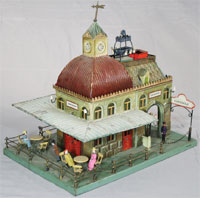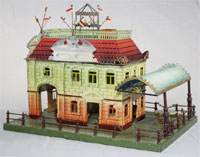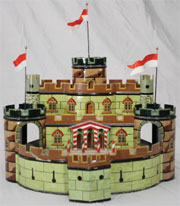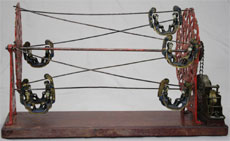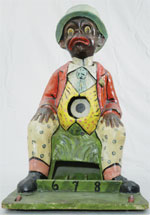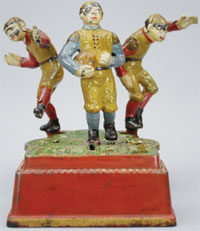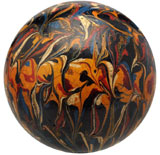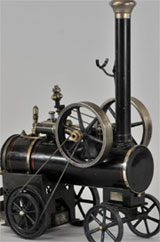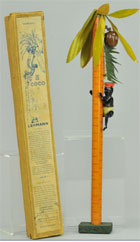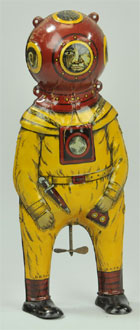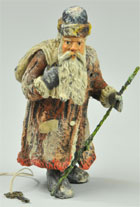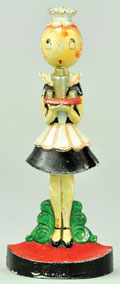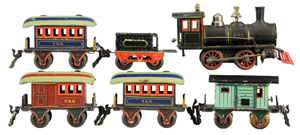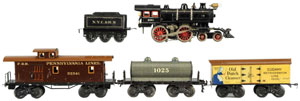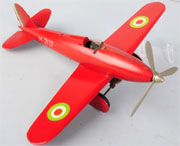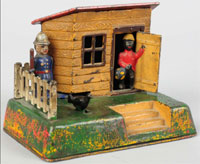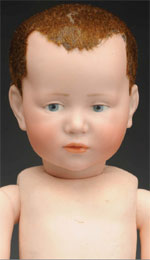Morphy’s June 1 auction a high-quality mix of antique advertising, coin-op machines and occupational shaving mugs from private collections
May 31st, 2013 by adminRover 1-cent Puss ‘N’ Boots fortune teller could reach $25,000-$30,000
DENVER, Pa. – Morphy’s is like a second home to antique advertising collectors, who regard the central Pennsylvania company’s auctions as a premier source of fresh-to-market pieces from long-held collections. On June 1st, Morphy’s will conduct a 537-lot specialty sale comprised exclusively of antique advertising, coin-op and penny arcade machines; and rare occupational shaving mugs. In keeping with their new, across-the-board policy, the auction will begin at 9 a.m. Eastern Time.

Buffalo Pepsin Gum 1-cent vending machine with brass marquee. Est. $5,000-$8,000. Morphy Auctions image.
The session will open with an exceptional single-owner collection of 150+ shaving mugs that includes several exciting rarities. Lot 29 depicts two men bowling and has an estimate of $1,500-$2,500; while Lot 122 features the image of an early airplane whose pilot wears duster-type goggles, est. $2,500-$3,000. An elusive stock market-related mug entered as Lot 89 is emblazoned with the image of a commodities broker writing numbers on a chalkboard. Although estimated at $2,500-$4,000, it “could go considerably higher,” according to Morphy Auctions CEO Dan Morphy. “Veteran collectors who’ve looked at it say it’s one of the best they’ve ever seen,” Morphy noted.
More than 150 gambling, vending and penny arcade machines lead the lineup of coin-operated amusements. Lot 189, a Buffalo Pepsin Gum vendor is expected to make $5,000-$8,000; while Lot 223, a Caille Centaur upright slot machine in beautiful condition could reach $25,000-$30,000. Lot 240, an original Mills 5-cent Frank Polk figural cowboy slot machine, is entered with a $20,000-$25,000 estimate. Polk produced only 70 original “cowboys,” the one in Morphy’s June 1 auction being one of them.
Other high-end machines include Lot 260, a Bally Reliance 5-cent dice machine, est. $8,000-$12,000; and Lot 295, a Rover 1-cent Puss ‘N’ Boots fortune teller machine, complete with 100 fortune cards, est. $25,000-$30,000. A highly desirable musical novelty of yesteryear, Lot 326 is a Wurlitzer Model 850 “Peacock” jukebox. Extremely rare and widely regarded as one of Wurlitzer’s most exquisite and colorful productions, it is estimated at $15,000-$18,000.
Next up will be 150+ lots of antique advertising. Lot 484, a circa-1910 to 1920 Phoenix Pure Paint curved porcelain corner sign, features the image of a Native-American boy. It is extremely scarce, as reflected in its presale estimate of $10,000-$15,000. Lot 500, a self-framed tin sign advertising Frazer Axle Grease, features a remarkable image of two horse-drawn wagons whose drivers are engaged in a discussion about a wheel problem. Estimate $4,000-$6,000.
The ever-popular Mr. Peanut will make an appearance in Lot 512, in the form of a life-size (75-inch-tall) papier-mache statue. The circa-1920s three-dimensional figure came from a Canadian collection and could bring $8,000-$12,000 on auction day.
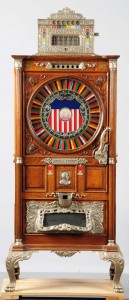
Mills 5-cent Dewey musical upright slot machine, working order with excellent repertoire of tunes. Est. $15,000-$18,000. Morphy Auctions image.
More than 100 tip trays, most in near-mint-plus condition, have come to Morphy’s from a single-owner collection. Standouts include Lot 346, a tip tray for J. Hupfel Brewing Co., est. $400-$800; and Lot 350, an example that advertises Rienzi Beer in bottles, est. $300-$600.
A fine selection of railroad-themed photos includes Lot 518, a litho print dated 1858 that depicts Boston Railroad Locomotive Works builders. The 29 x 42in print is estimated at $5,000-$8,000. Another highlight is Lot 522, a ruby ambrotype photo of a locomotive, est. $800-$1,200.
“Our advertising sales are always enjoyable,” said Dan Morphy. “Collectors appreciate the fact that we’re very particular about the condition and quality of pieces accepted for consignment, and those who cannot bid in person never have to worry about our descriptions and condition reports. They know they can trust them one hundred percent.”
Morphy’s Saturday, June 1 auction of antique advertising, coin-op machines and occupational shaving mugs will commence at 9 a.m. Eastern Time. All forms of bidding will be available, including live via the Internet through Morphy Live or Artfact.com.
Morphy Auctions is located at 2000 N. Reading Rd., Denver, PA 17517. For additional information, call 717-335-3435 or e-mail serena@morphyauctions.com. View the fully illustrated catalog online at www.morphyauctions.com or www.artfact.com.



